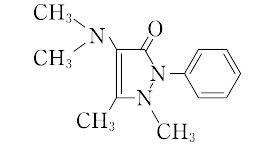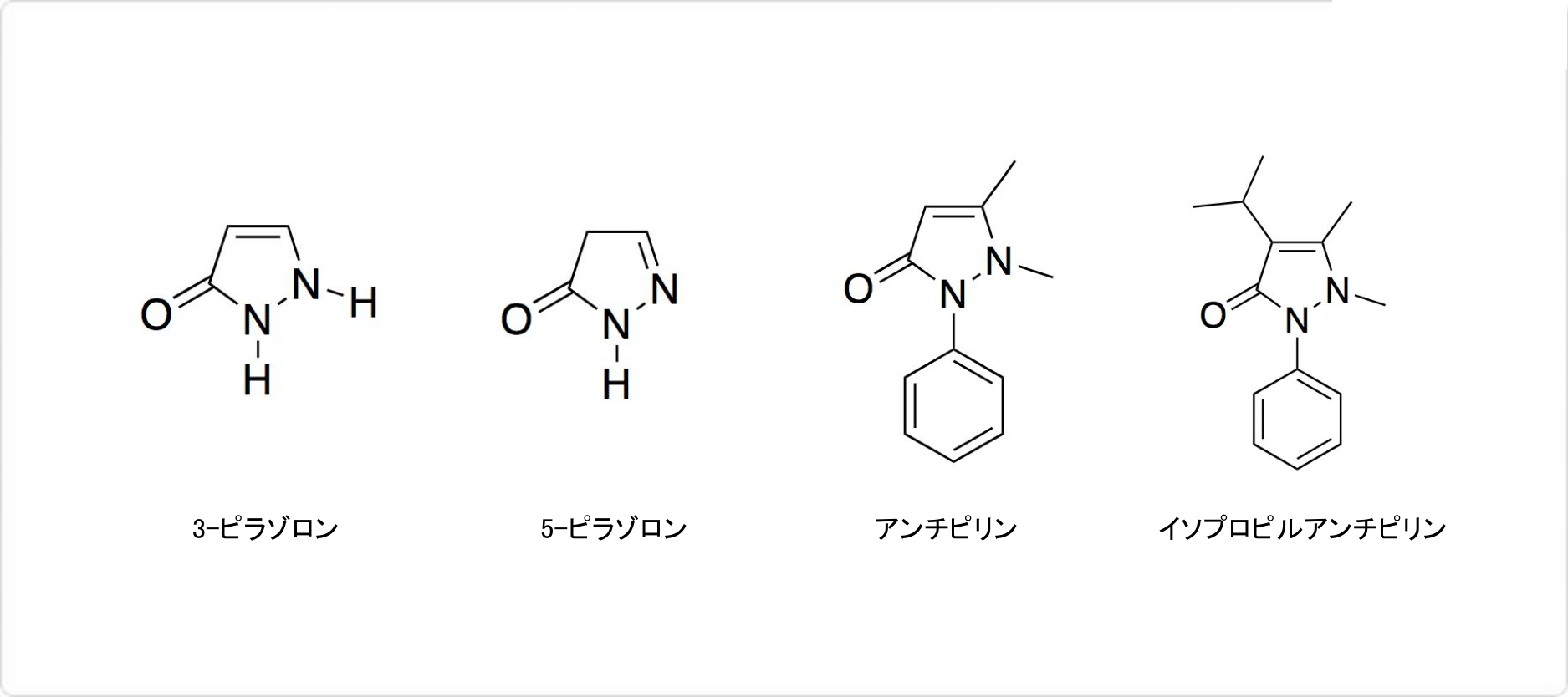アミノピリン 化学特性,用途語,生産方法
外観
白色~わずかにうすい黄色, 結晶~結晶性粉末
性質
アミノピリンは、とによく溶け、エーテルや水にも溶けます。融点は、107〜109℃です。わずかな苦味がありますが、においはありません。
光で変化します。還元性を有し、酸化剤が存在すると、青~紫色を呈します。また、ピラゾロン骨格を有しています。化学式はC13H17N3Oで表せます。分子量は231.29358です。
溶解性
クロロホルム, エタノールに易溶, 水, エーテルに可溶。エタノールに溶けやすく、水及びエーテルにやや溶けやすい。
解説
4-dimethylamino-2,3-dimethyl-1-phenyl-5-pyrazolone.C13H17N3O(231.30).アセト酢酸エステルとフェニルヒドラジンから3-メチル-1-フェニル-5-ピラゾロンを合成し,これをN-メチル化,ニトロソ化,還元,メチル化の工程を経て製造される. "無色または白色の結晶,あるいは結晶性粉末.無臭.味はわずかに苦い.融点107~109 ℃.クロロホルム,エタノールに易溶,水,エーテルに可溶.光によって変化する.還元性があり,酸化剤の共存で,青~紫色の呈色反応を示す.ピラゾロン系合成解熱·鎮痛薬として用いられる.薬効はアンチピリンの約3倍.吐き気,頻脈,ヘマトポルフィリン尿症,無顆粒細胞症などの副作用を起こすことがある.[CAS 58-15-1]
"無色または白色の結晶,あるいは結晶性粉末.無臭.味はわずかに苦い.融点107~109 ℃.クロロホルム,エタノールに易溶,水,エーテルに可溶.光によって変化する.還元性があり,酸化剤の共存で,青~紫色の呈色反応を示す.ピラゾロン系合成解熱·鎮痛薬として用いられる.薬効はアンチピリンの約3倍.吐き気,頻脈,ヘマトポルフィリン尿症,無顆粒細胞症などの副作用を起こすことがある.[CAS 58-15-1]
森北出版「化学辞典(第2版)
用途
肝薬物代謝酵素活性測定、胃粘膜血流測定、糞便の潜血反応試験。
副作用
1922年に頸部疾患が発症し、原因が無顆粒球症だと報告されました。アミノピリンが原因の血球減少は、因果関係が認められていましたが、その後も広く一般的に使われました。無顆粒球症の発生率は、日本人の場合は非常に稀です。ただし発生した場合の死亡率は、20〜50%です。
アミノピリンによって、消化管内でニトロソ化反応が起こります。この反応が発癌に繋がる可能性が指摘されたため、使用を禁止する国が増えました。1977年に日本でも経口での利用が禁止され、1979年に日本薬局方から削除されました。現在では一部の動物用医薬品としてのみ、注射剤が用いられています。
合成法
アミノピリンの合成の歴史は、1884年にルートヴィヒ・クノール (英: Ludwig Knorr) によって、アンチピリン (英: antipyrine) 、、から、4-アミノアンチピリンが合成されたことで始まりました。
その後、1896年から1897年にかけて、ヴィルヘルム・フィレーネ (英: Wilhelm Filehne) が、4-アミノアンチピリンからアミノピリンを創製しました。
効能
抗炎症薬
化学的特性
White leaf-like crystals or crystalline powder. Odorless, slightly bitter taste. It is stable in the air, but will deteriorate in sunlight. When there is moisture, it is easy to chemically react with weak oxidants. Soluble in alcohol, chloroform, benzene and ether, soluble in water. The solubility in water increases with the addition of sodium benzoate. Aqueous solutions are weakly alkaline to litmus. The melting point is 107-109°C.
使用
Aminopyrine is used as an antipyretic and analgesic drug. It belongs to the pyrazolone derivatives having a most toxic and most dangerous analgesic effect and it is a non-narcotic drug. Due to strong adverse effects, its single medicine preparation is gradually replaced by compound preparation.
製造方法
Aminopyrine is synthesized from 4-Aminoantipyrine by catalytic hydrogenation (alkylation). Water is firstly added to the dissolving tank, heated to 50-60°C, put into 4-Aminoantipyrine under stirring, and poured into the hydrogenation tank after complete dissolving. Wash the dissolving tank with water, mix it with the nickel catalyst, and then add it to the hydrogenation tank. The hydrogenation tank was evacuated, then the vacuum valve was closed, hydrogen was introduced, and stirring was started. When the pressure rose to 0.245MPa, the hydrogen was stopped. Add formaldehyde and continue to feed hydrogen. The speed of adding formaldehyde is based on the standard of 1.8-2 cubic meters of hydrogen absorption per 5L of formaldehyde, and the reaction temperature is controlled at 60-85°C. After passing the test, filter by pressure, cool the filtrate to below 25°C, and separate out crystals, which are then filtered to obtain the crude aminopyrine. The crude aminopyrine, ethanol, and activated carbon were heated to 75-80°C, stirred for 1 hour, and filtered under pressure. The filtrate was cooled to 10°C, crystals were precipitated, filtered, washed with ethanol, and air-dried to obtain aminopyrine.
定義
ChEBI: Aminopyrine is a pyrazolone that is 1,2-dihydro-3H-pyrazol-3-one substituted by a dimethylamino group at position 4, methyl groups at positions 1 and 5 and a phenyl group at position 2. It exhibits analgesic, anti-inflammatory, and antipyretic properties. It has a role as a non-steroidal anti-inflammatory drug, a non-narcotic analgesic, an antipyretic, an environmental contaminant and a xenobiotic. It is a tertiary amino compound and a pyrazolone.
世界保健機関(WHO)
Aminophenazone, a pyrazolone derivative, has been used as an
antiinflammatory and analgesic agent for over a century. Its use has been
associated with cases of bone marrow depression and agranulocytosis and more
recently it has been claimed to have a carcinogenic potential. Products containing
aminophenazone have been formally withdrawn in many countries and marketing
has been voluntarily suspended in others. Elsewhere, however, proprietary
preparations containing this ingredient may remain available.
(Reference: (WHODI) WHO Drug Information, 3, 9, 1977)
一般的な説明
Small colorless crystals or white crystalline powder. Aqueous solution slightly alkaline to litmus. pH (5% water solution) 7.5-9. Odorless. Slightly bitter taste.
空気と水の反応
Water soluble.
反応プロフィール
Aminophenazone is sensitive to exposure to light. Aminophenazone is readily attacked by mild oxidizing agents in the presence of water. Aminophenazone is incompatible with acacia, apomorphine, aspirin, chloral hydrate, iodine and tannic acid.
火災危険
Flash point data for Aminophenazone are not available; however, Aminophenazone is probably combustible.
類似物です

図3. ピラゾロンの構造
アミノピリンは、ピラゾロン誘導体です。ピラゾロンとは、カルボニル基を持っており、複素環式化合物に分類される5員環のラクタムです。ピラゾリン (英: pyrazoline) の1個の水素基がカルボニル基に変換された構造であり、3-ピラゾロンや5-ピラゾロンが存在します。
アンチピリンやイソプロピルアンチピリンも、ピラゾロン誘導体です。
による効能
アンチピリンと同じく、アミノピリンには解熱効果があります。その効力は、アンチピリンのおよそ3倍です。
鎮痛作用は、アンチピリンやイソプロピルアンチピリンより強いです。
薬物動態学

図2. ルバゾン酸の構造
グルクロン酸抱合によって、体内でアミノピリンはと結合して、ルバゾン酸 (英: Rubazonic acid) などに変わって、尿中に排泄されます。このとき尿は赤色を呈します。
使用用途
アミノピリンは、ドイツのヘキスト社 (英: Hoechst) により解熱鎮痛剤として販売され、広く使用されていました。アミノピリンが作用する主な理由は、発熱や痛みを引き起こす生理活性物質であるプロスタグランジン (英: prostaglandin) の合成を阻害できるためです。また、視床下部に作用するため鎮痛作用を有します。
しかし、アミノピリンによって、無顆粒球症を引き起こすなどの強い副作用が報告されました。さらに、発がん性物質であることが示唆されたため、現在は解熱鎮痛剤として使用されなくなりました。
安全性プロファイル
Human poison by
unspecified route. Experimental poison by
ingestion, subcutaneous, intramuscular,intravenous, and intraperitoneal routes.
Moderately toxic by parenteral route.
Experimental teratogenic and reproductive
effects. Questionable carcinogen when
mixed with NaNO2 (1:l). Mutation data
reported. Can cause bone marrow
depression resulting in leucopenia. Has been
implicated in development of aplastic
anemia. A tranquilizer. When heated to
decomposition it emits toxic fumes of NOx.
純化方法
It crystallises from pet ether, sublimes between 80o and 90o, and forms metal complexes. [Beilstein 25 H 452, 25 III/IV 3555.]
アミノピリン 上流と下流の製品情報
原材料
準備製品